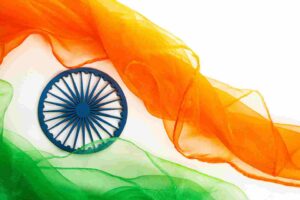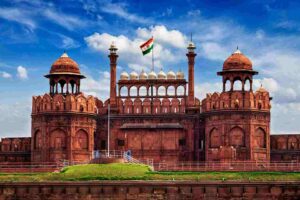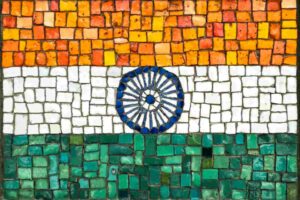The attainment of independence by India marked a significant milestone in the nation’s history. The journey towards Indian independence was long, fraught with numerous challenges, sacrifices, and heroic acts of defiance against the British Raj. This article aims to provide an in-depth analysis of the Indian independence movement, the key events and figures that shaped the course of this historical journey, and the cultural significance of this epoch-making event.

The Genesis: Opposing British Rule (1857-1947)
The Indian independence movement, often regarded as one of the most remarkable chapters in the country’s history, began as a series of historical events to end British rule in India, popularly known as the British Raj. From 1857 to 1947, this significant period witnessed the rise of fervent nationalist activities, civil disobedience, and revolutionary movements, all united by the common goal of liberating India from British imperialism.
At its core, the genesis of this nationalist fervor can be traced back to the first revolutionary movement for Indian independence that emerged from the vibrant region of Bengal. Here, the seeds of resistance were sown, inspiring and igniting the flame of patriotism that would spread throughout the nation. As the flames of discontent grew stronger, the need for a united front became evident.
In response to this growing desire for freedom, the Indian National Congress emerged in the late 19th century as a crucial catalyst for change. This organization played a pivotal role in channeling the aspirations and grievances of the Indian people, providing a platform for their voices to be heard. Through its tireless efforts, the Indian National Congress became the driving force behind the movement, mobilizing the masses and demanding their rights.
The Indian independence movement, with its rich tapestry of heroes, visionaries, and ordinary citizens-turned-revolutionaries, transcended geographical boundaries and societal differences. It became a unifying force, bringing together people from all walks of life in their quest for freedom and self-determination.
The struggle for Indian independence was not without its challenges and sacrifices, but the unwavering spirit of those involved remained steadfast. From the nonviolent resistance led by Mahatma Gandhi and his philosophy of Satyagraha to the armed uprisings spearheaded by revolutionaries like Bhagat Singh, the movement encompassed a wide spectrum of ideologies and approaches, all united by the shared dream of a free and sovereign India.
The First Half of the 20th Century: Radicalism and Non-Violence

The Indian struggle for independence during the first half of the 20th century was marked by a radical approach towards self-rule, led by influential leaders who left an indelible mark on the nation’s history. One triumvirate that played a pivotal role in the fight for freedom was the Lal Bal Pal, comprising Lala Lajpat Rai, Bal Gangadhar Tilak, and Bipin Chandra Pal. These visionaries passionately advocated for the rights and autonomy of the Indian people, igniting a flame of nationalism that would burn brightly for generations to come.
In addition to the Lal Bal Pal triumvirate, other noteworthy leaders contributed significantly to the cause of Indian independence. Aurobindo Ghosh, a spiritual and political leader, and V. O. Chidambaram Pillai, a revolutionary freedom fighter, played instrumental roles in galvanizing the masses and strengthening the resolve of the Indian people.
However, the struggle for independence took on a new dimension under the leadership of Mahatma Gandhi. Gandhi’s philosophy of non-violence and civil disobedience resonated deeply with the Indian National Congress and its followers, sparking a wave of peaceful protests and resistance against British rule. The impact of Gandhi’s leadership and his message of peace and unity cannot be overstated when discussing the Indian independence movement.
Beyond the leaders actively involved in direct political action, several other key figures left an indelible mark on the journey toward independence. Jawaharlal Nehru, the first Prime Minister of India, and Vallabhbhai Patel, the “Iron Man of India,” were instrumental in shaping the nation’s future and ensuring its unity after achieving independence.
Abdul Ghaffar Khan, also known as the “Frontier Gandhi,” played a crucial role in mobilizing the people of the North-West Frontier Province, now known as Khyber Pakhtunkhwa, against British rule. His commitment to non-violence and tireless efforts to empower the local population made him a revered figure in the struggle for independence.
Additionally, Maulana Azad, a prominent Indian scholar, and politician, contributed extensively to the independence movement. As the president of the Indian National Congress, Azad played a vital role in organizing and mobilizing the masses, fostering a sense of unity and determination among Indians.
In addition to these political and social leaders, several intellectuals played a vital role in spreading the message of patriotism and inspiring the masses. Rabindranath Tagore, the Nobel laureate poet, and philosopher, used his literary genius to kindle a sense of national pride among the Indian population. Bankim Chandra Chattopadhyay, the author of India’s national song, “Vande Mataram,” played a similar role, his words becoming a rallying cry for freedom.
Women in the Independence Struggle
The freedom struggle for Indian independence was not just a fight led by men but also saw the active participation of women. These brave women leaders, such as Sarojini Naidu, Vijaya Lakshmi Pandit, Pritilata Waddedar, and Kasturba Gandhi, played a significant role in promoting the emancipation of Indian women and their active involvement in the struggle for independence. Their relentless efforts and inspiring contributions laid the cornerstone for gender equality and women’s rights in independent India.
Sarojini Naidu, the Nightingale of India, was a poet and a prominent political activist. She fearlessly fought against British imperial rule and used her powerful words to inspire and unite the Indian population. Vijaya Lakshmi Pandit, the sister of Jawaharlal Nehru, was also a key figure in the fight for independence. She played a vital role in the Indian National Congress and represented India in various international forums, advocating for the country’s independence.
Pritilata Waddedar, a lesser-known but equally remarkable figure, is remembered for her bravery in leading an armed attack against the British in 1932. She sacrificed her life for the cause of freedom, leaving a lasting impact on the struggle for independence. Kasturba Gandhi, the wife of Mahatma Gandhi, was not only a pillar of support for her husband but also an active participant in the freedom movement. She played a crucial role in mobilizing women and spreading the message of non-violence.
The Violent Approach: The Rowlatt Act and Jallianwala Bagh Massacre

The Indian independence movement was a tumultuous historical period characterized by various approaches, including peaceful protests and violent resistance. One such instance of violent suppression was witnessed during the enactment of the Rowlatt Act, which allowed for indefinite detention. This act ignited a flame of resistance among the Indian population, resulting in widespread nationwide protests.
However, the British rulers responded brutally, especially in the Punjab province, where a tragic event forever etched in history occurred – the Jallianwala Bagh massacre. This horrific incident unfolded on April 13, 1919, when British troops, under the orders of Brigadier General Reginald Dyer, opened fire on a peaceful gathering of men, women, and children.
The Jallianwala Bagh massacre proved a significant turning point in the Indian independence struggle. It deeply impacted the collective consciousness of the Indian people, fueling a wave of anger, resentment, and determination against the oppressive British Raj. The incident galvanized individuals from all walks of life, uniting them in their quest for freedom and sovereignty.
The brutality and bloodshed witnessed on that fateful day in Amritsar stirred up a sense of urgency and solidarity among the Indian populace. The Indian National Congress and other political and social organizations intensified their efforts to end British rule and attain independence.
This dark chapter in history remains a poignant reminder of the sacrifices made by countless individuals to pursue freedom. The Jallianwala Bagh massacre served as a catalyst, propelling the Indian independence movement forward with unwavering resolve and a renewed determination to break free from colonial dominance.
Ideological Evolution of the Movement
The Indian independence movement, a pivotal chapter in history, witnessed a constant evolution of ideologies that shaped the course of the nation’s destiny. From its inception, the movement was driven by a resolute anti-colonial sentiment, as Indians yearned for freedom from the shackles of British rule. However, as time progressed, the movement’s aspirations expanded, encompassing political emancipation and a vision for independent economic development.
In its quest for true independence, the Indian freedom movement recognized the significance of a secular, democratic, republican, and civil-libertarian political structure. It understood that merely breaking free from foreign dominance was insufficient; the nation needed a solid foundation to ensure its citizens’ rights and freedoms for future generations. The movement rallied behind these ideals, uniting people from diverse backgrounds for a common cause.
As the 1930s dawned, a new wave of thought shaped the Indian independence movement. This wave carried a strong socialist orientation that sought to address the socioeconomic disparities that plagued the nation. The movement recognized that political freedom alone would not suffice if the people continued to suffer under the burdens of poverty and inequality. Therefore, the fight for independence became intertwined with pursuing a more egalitarian society, where opportunities were not limited to a privileged few but extended to all.
This powerful fusion of socialist ideals with the overarching goal of independence culminated in the historic Indian Independence Act of 1947. This landmark legislation marked the end of British colonial rule in India, granting the nation the long-awaited freedom it had yearned for. The Indian independence movement had successfully navigated a complex web of ideologies, transforming itself into a force that championed political liberation and strived for a fairer, more prosperous future.
The Birth of a Nation and the End of an Era
The Indian Independence Act of 1947 effectively ended British Crown suzerainty, partitioning British Raj into the Dominion of India and Pakistan. However, India retained its status as a Crown Dominion until 26 January 1950, when the Constitution of India established the Republic of India.
The end of British rule did not just signify Indian independence but also marked the beginning of a new era of self-governance and self-determination. The transition from a British colony to an independent nation-state was not smooth, marked by the tragic partition of India and the ensuing communal violence.
Celebration of Independence: A Symbol of National Pride
On 15 August every year, India celebrates its Independence Day. This day commemorates the nation’s independence from British rule and is observed with much fervor and patriotism across the country. The main event occurs in Delhi, where the Prime Minister hoists the Indian flag at the Red Fort and delivers a speech highlighting the nation’s accomplishments and future challenges.
Independence Day is a day of national pride, a day to remember the sacrifices made by countless freedom fighters and to celebrate the unity in diversity that characterizes India. Various cultural and patriotic events are held nationwide, making Independence Day one of the most significant days in the Indian calendar.
Indian Independence Day: A Legacy of Struggle and Triumph
The story of Indian independence is a testament to the indomitable spirit of a nation that refused to bow down to foreign rule. It is a saga of sacrifice, bravery, and unwavering determination. The struggle for independence was a political movement and a social and cultural revolution that forever altered the course of Indian history.
On Independence Day, Indians pay homage to the heroes of the independence struggle and celebrate the values of freedom, democracy, and unity that define their nation. The legacy of the independence struggle continues to inspire, reminding every Indian of their duty towards their country and fellow citizens.
Conclusion

The journey toward Indian independence was remarkable, filled with countless sacrifices, acts of defiance, and heroic struggles. From the non-violent resistance led by Mahatma Gandhi to the valiant efforts of countless freedom fighters, the Indian people left no stone unturned in their quest for liberation. It was a battle fought on the streets and in the people’s hearts, and their unwavering determination eventually bore fruit.
The triumphant attainment of independence on August 15, 1947, marked a turning point in India’s history. It was a moment of immense joy and pride as the Indian people finally achieved their long-cherished dream of self-rule. By establishing a democratic nation-state, India emerged as a shining example of the power of unity and perseverance.
Today, as India continues to grow and progress, the legacy of the independence struggle remains a constant source of inspiration. It serves as a reminder of the immense courage and sacrifice of those who came before us and their unwavering commitment to freedom, unity, and democracy.
The values of freedom, unity, and democracy, which were the guiding principles of the Indian independence movement, continue to form the bedrock of the Indian nation. They are the pillars upon which our great country stands and are the essence of what it means to be an Indian.
The journey toward Indian independence was not an easy one, but it was a journey that was worth every sacrifice and struggle. It is a testament to the indomitable spirit of the Indian people, who refused to be silenced or suppressed. Their determination and resilience have shaped the India we know today – a vibrant, diverse, and democratic nation admired by the world.
As we commemorate the heroes of the independence struggle, let us also remember that the fight for freedom is ongoing. It is a responsibility that each one of us carries to protect and uphold the values that our forefathers fought so bravely for. Let us embrace the legacy of the independence struggle and work together to build a brighter future for our beloved nation.